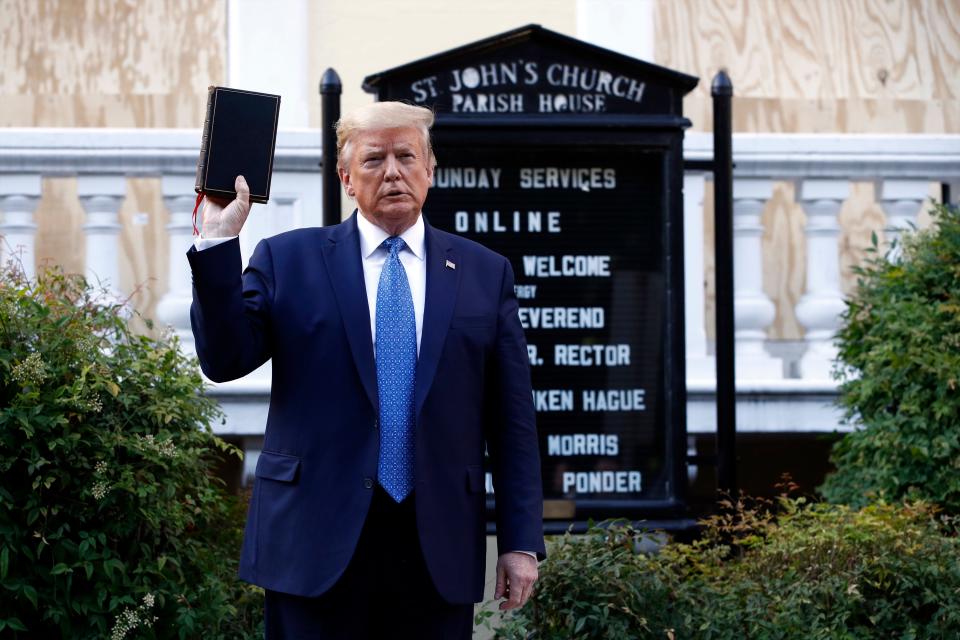National Guard major tells lawmakers he saw 'excessive' force used on protesters near the White House
WASHINGTON – A major in the District of Columbia National Guard told lawmakers he saw "excessive" force used in June when law enforcement cleared protesters gathered near the White House ahead of President Trump's controversial photo opportunity at St. John's Church.
Maj. Adam DeMarco, who served as a liaison between the D.C. National Guard and the Park Police at Lafayette Square, told lawmakers the disproportionate use of force he witnessed against largely peaceful protesters was "deeply disturbing" to him and other Guardsman.
The National Guard was not actively involved in the clearing of protesters on June 1 but was at the scene to "reinforce and relieve" the Park Police if needed, according to DeMarco's written testimony.
DeMarco spoke Tuesday before the House Natural Resources Committee along with acting U.S. Park Police Chief Gregory Monahan, who defended his agency's actions. Monahan told lawmakers the protesters were pushed back that day because of "sustained" violent incidents and violent confrontations with law enforcement.

DeMarco said the clearing of protesters happened earlier than the Guard had expected and took place 40 minutes before D.C. Mayor Muriel Bowser's curfew was set to go into effect, and about 20 minutes before Trump gave a speech in the White House Rose Garden calling for an end to violent protests.
On the evening of June 1, demonstrators protesting the death of George Floyd and police brutality were forcibly removed from the Lafayette Square by authorities, some on horseback, using chemical irritants, rubber bullets and shields. Trump then walked with members of his administration to historic St. John's Church, where a fire had occurred the night before, and posed with a Bible, drawing wide condemnation.
More: How police pushed aside protesters ahead of Trump's controversial church photo
The Trump administration has denied any connection between the photo and the clearing of protesters and had denied the use of tear gas on the protesters.
DeMarco, however, told lawmakers he felt irritation in his eyes and nose at the time, and based on exposure to tear gas both at West Point and in the Army, the effects were "consistent with CS or 'tear gas.'" He later found spent tear gas canisters on the street, but he was told by Park Police no tear gas was used that day against protesters, and that the smoke at the scene was "stage smoke."
"From my observation, those demonstrators – our fellow American citizens – were engaged in the peaceful expression of their First Amendment rights. Yet they were subjected to an unprovoked escalation and excessive use of force," DeMarco said.
House Natural Resources Committee Chairman Raul Grijalva, D-Ariz., said what he heard from the Trump administration on its response to protests were "outright lies" and warned of "creeping authoritarianism" in its heavy-handed responses to protests.

Speaking before DeMarco, Monahan told lawmakers that de-escalation of the situation required the installation of a tall fence around the White House.
The clearing of protesters attracted criticism, according to Monahan, but was a "key tactic that served to greatly reduce the violent behavior of bad actors."
He said the protests were some of the "most violent protests that I've been a part of my 23 years of the United States Park Police," citing arson, vandalism, and injuries sustained by over 50 officers.
The Park Police exercised "tremendous restraint," Monahan said, a claim Rep. Mike Levin, D-Calif., said he found "hard to believe."

According to Monahan, Attorney General Barr did not give the order to clear the protesters, nor did White House officials or Interior Secretary David Bernhardt. A senior Justice Department official USA TODAY the day after the demonstration that Barr ordered protesters to be cleared.
Testifying nearby in another hearing before the House Judiciary Committee, Barr told lawmakers there had been discussion on June 1 about moving protesters back, but plans were made before he knew about Trump's visit to the church. The plan had been put in place the night before, he said, and then carried out by a commander with the U.S. Park Police.
Barr contended that the order was not connected to clearing the area so that Trump could stage a photo opportunity at the church.
“We didn’t invade the Philippines so that Douglas MacArthur could walk to the beach,” Barr said, referring to the iconic photograph of the U.S. general wading to the Philippine shore in 1944.
Asked whether the Park Police had used tear gas against the protesters on June 1, Monahan said the Park Police's rules of engagement "specifically prohibited the use of CS gas on June 1," but they did use smoke canisters and "Stinger ball" grenades that explode and disperse rubber pellets.
In response to Monahan's testimony, Democratic lawmakers connected the clearing of protesters to current controversy over the Trump administration's response to protests in Portland and Seattle. Grijalva slammed the incident as "motivated by partisan hostility directed from above" against Black Lives Matter protesters.
Rep. Jody Hice, R-Ga., by contrast, decried the hearing format as creating a "pre-determined narrative" about Lafayette Square, whereas the "reality of the case is much different." Law enforcement was simply involved in "restoring the peace" on June 1, he said.
More: Attorney General Barr ordered park protesters cleared before Trump's visit to St. John's church
The Interior Department's inspector general's office later opened an investigation into the clearing of protesters.
Former Trump Defense Secretary James Mattis blasted the administration for clearing the protesters and called the event a "bizarre photo op." Chairman of the Joint Chiefs of Staff Mark Milley, who accompanied Trump and other top administration officials to St. John's Church, later said it was a "mistake" for him to participate in the walk to the church.
More: Pentagon leaders say they don't know who gave order to clear Lafayette Square protesters
Contributing: Kevin Johnson

This article originally appeared on USA TODAY: National Guard officer: 'Excessive' force used before Trump photo op

